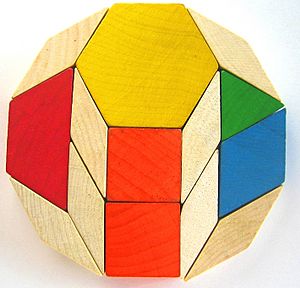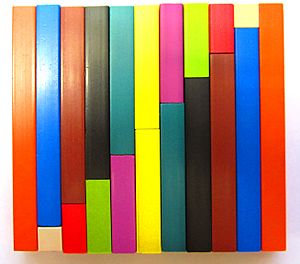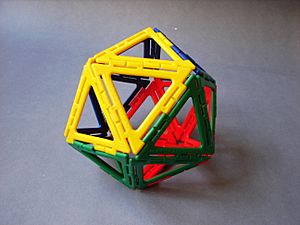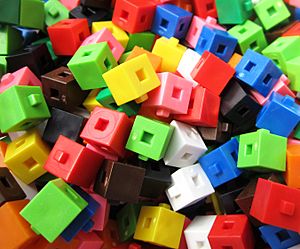Manipulative (mathematics education) facts for kids
In school, a manipulative is a special object that helps you understand math ideas. You learn by holding and moving these objects. It's a hands-on way to explore math concepts.
Using manipulatives became very popular in math classes around the world in the second half of the 1900s. They are often the first step in learning new math ideas. This first step is called "concrete representation," meaning you use real objects. After that, you move to "representational" (like drawing pictures) and then "abstract" (just using numbers and symbols).
Teachers can buy math manipulatives or even make them. Some common ones you might see are Unifix cubes, tangrams, Cuisenaire rods, and base ten blocks. Other examples include interlocking cubes, pattern blocks, and geoboards. Teachers can also make simple ones, like using beans or popsicle sticks to teach about place value.
There are also virtual manipulatives. These are computer versions of the physical objects. You can use them online to explore math concepts.
Using manipulatives many times helps you build a strong understanding of math. It helps you see how math ideas work in a real way.
Sometimes, manipulatives are used in other subjects too. For example, Cuisenaire rods can help with language arts. Pattern blocks are sometimes used in art classes.
Contents
Using Manipulatives in Learning
Math manipulatives are super important for young people learning math. These real objects help you understand big math ideas. Then, they help you connect those ideas to drawings and abstract numbers.
For example, some manipulatives are made to help you learn about fractions, shapes, or even algebra. Let's look at a few common ones. We'll see how pattern blocks, interlocking cubes, and tiles can help you learn. This is just a small peek at all the cool things you can do with them!
Base Ten Blocks
Base ten blocks are great for learning about place value. They help you see how numbers are built. The smallest blocks are "ones." The long rods are "tens." The flat squares are "hundreds," and the big cubes are "thousands."
These blocks are different sizes to show their value. This makes them perfect for exploring numbers. You can use them to physically show addition, subtraction, multiplication, and division. It helps you understand how these operations work with place value.
Pattern Blocks

Pattern blocks are usually wooden shapes. They come in different colors like green triangles, red trapezoids, yellow hexagons, and blue rhombi. They are made so that they fit together in special ways.
For example, three green triangles can make a red trapezoid. Two red trapezoids can make a yellow hexagon. Playing with these shapes helps you understand how shapes are put together and taken apart. This is a key part of learning early geometry.
Teachers also use pattern blocks to help you find, continue, and create patterns. A teacher might show you a pattern like: hexagon, triangle, triangle, hexagon. You can then guess "what comes next" and add blocks to continue the pattern. It's important to make patterns using real objects like these blocks.
Pattern blocks can also help you understand fractions. Because the blocks fit together (like six triangles making one hexagon), you can see what halves, thirds, and sixths look like. It's a hands-on way to learn about parts of a whole.
Many people also use pattern blocks to create cool art, like mosaics. You can make over 100 different pictures, including cars, animals, and flowers. The fun part is that you can easily change your art or turn it into something new!
Unifix® Cubes
Unifix® Cubes are small cubes that link together. They are just under 2 centimeters on each side. The cubes connect from one side. Once connected, you can make a tall "tower" or a long "train."
Other linking cubes are also available in different sizes, like 1 centimeter or 1 inch. These are great for measuring things.
Like pattern blocks, linking cubes are excellent for teaching patterns. You can use them to build long pattern trains. They give you a real way to find, continue, and create patterns. A cool thing about linking cubes is that you can easily break a pattern apart by its repeating unit.
For example, if you made a pattern like: Red, blue, blue, blue, red, blue, blue, blue... You could then find the repeating part (red, blue, blue, blue) and take the pattern apart unit by unit.
You can also use these cubes to learn addition, subtraction, multiplication, and division. They help with guessing, measuring, graphing, and understanding perimeter, area, and volume.
Tiles
Tiles are usually one-inch by one-inch colored squares. They often come in red, green, yellow, and blue.
You can use tiles in many ways, similar to linking cubes. The main difference is that tiles don't lock together. They stay as separate pieces. This can be very useful in certain learning activities.
These three types of manipulatives (pattern blocks, linking cubes, and tiles) can teach many of the same ideas. It's important to learn math concepts using different tools. For example, when you learn to make patterns, try making them with all three tools. Seeing the same idea in different ways helps you understand it even better.
Number Lines
To learn how to add and subtract positive and negative numbers, a number line is often used. A typical number line might go from -20 to 20. For a problem like "-15 + 17," you would find -15 and then count 17 spaces to the right.
- Allsopp. D.H. (2006), Concrete – Representational – Abstract.
- Krech, B. (2000). "Model with manipulatives." Instructor, 109(7):6–7.
- Van de Walle, J., & L.H. Lovin. (2005). Teaching Student-Centered Mathematics: Grades K-3. Allyn & Bacon.
- Didax Virtual Manipulatives





